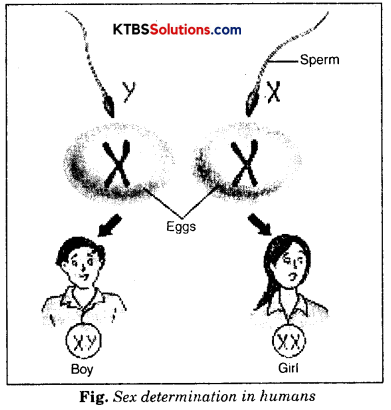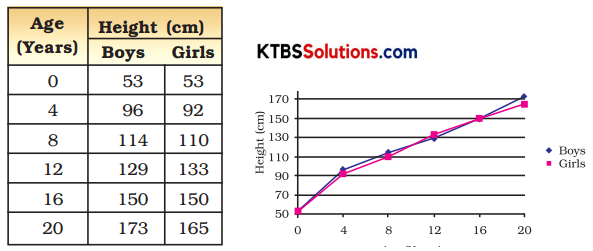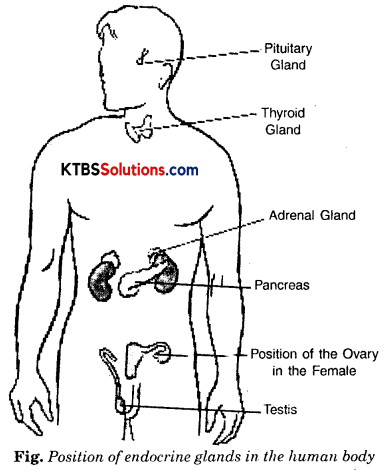You can Download KSEEB Solutions for Class 8 Science Chapter 13 Reaching the Age of Adolescence Questions and Answers Pdf, Notes help you to revise the complete syllabus.
KSEEB Solutions for Class 8 Science Chapter 13 Reaching the Age of Adolescence
Reaching the Age of Adolescence Textbook Questions and Answers
Question 1.
What is the term used for secretions of endocrine glands responsible for changes taking place in the body?
Answer:
Hormones are the term used for secretions of endocrine glands responsible for changes taking place in the body.
![]()
Question 2.
Define adolescence.
Answer:
Adolescence. The period of life, when the body undergoes changes, leading to reproductive maturity is called adolescence.
Question 3.
What is menstruation? Explain.
Answer:
If fertilization does not take place then the thickened inner wall of the uterus break down along with the blood vessels and move out of the vagina in the form of bleeding. This is known as menstruation which lasts for 4-7 days.
Question 4.
List the changes in the body that take place at puberty.
Answer:
The changes in the body that take place at puberty are:
- Increase in height.
- Change in body shape – Boys have broader shoulders and wider chests. In girls, the region below the waist becomes wider.
- There is a change in voice. Girls have a high-pitched voice, whereas boys have a deep voice.
- The secretion of sweat glands and sebaceous glands (oil glands) increases.
- There is the development of sex organs. Male sex organs (testes, penis) are fully developed and produce sperms. In girls, the ovaries enlarge and eggs begin to mature. Ovaries start releasing matured eggs.
- A person reaches mental, intellectual, and emotional maturity.
![]()
Question 5.
Prepare a table having two columns depicting names of endocrine glands and hormones secreted by them.
Answer:
| Endocrine organs | Hormones secreted |
| 1. Pituitary gland | (i) Growth hormone (ii) ACTH (iii) FSH (iv) TSH (v) Oxytocin |
| 2. Thyroid | Thyroxine |
| 3. Pancreas | Insulin |
| 4. Adrenal | Adrenaline |
| 5. Pancreas | (i) Insulin (ii) Glucagon |
| 6. Ovary | (i) Estrogen (ii) Progesterone |
| 7. Testis | Testosterone |
Question 6.
What are sex hormones? Why are they named so? State their function.
Answer:
Sex hormones are hormones secreted by the testes and ovaries. They are named so because they are responsible for the male and female secondary sexual characters. The function of male sex hormones is to cause changes in boys like the growth of facial hair, that is mustaches and beard. The function of the female sex hormone is to cause changes in girls like the development of breasts.
Question 7.
Choose the correct option.
(a) Adolescents should be careful about what they eat, because:
(i) Proper diet develops their brains.
(ii) Proper diet is needed for the rapid growth taking place in their body.
(iii) Adolescents feel hungry all the time.
(iv) Taste buds are well developed in teenagers.
Answer:
(ii) Proper diet is needed for the rapid growth taking place in their body.
![]()
(b) Reproductive age in a woman starts when their:
(i) Menstruation starts.
(ii) Breasts start developing.
(iii) Bodyweight increases.
(iv) Height increases.
Answer:
(i) Menstruation starts.
(c) The right meal for adolescents consists of:
(i) Chips, noodles, coke.
(ii) Chapati, dal, vegetables.
(iii) Rice, noodles, and burger.
(iv) Vegetable cutlets, chips, and lemon drink.
Answer:
(ii) Chapati, dal, vegetables.
Question 8.
Write notes on:
(i) Adam’s apple
(ii) Secondary sexual characters.
(iii) Sex determination in the unborn baby.
Answer:
(i) Adam’s apple: Adam’s apple is a protruding part of the throat in adolescent boys. This is a large voice box or the larynx. Due to this, the voice in boys is deep. If the muscles of the growing voice box go out of control then the voice becomes hoarse.

(ii) Secondary sexual characters: The features which help to distinguish the male from the female are called secondary sexual characters.
The secondary sexual characters in girls are:
- The hips become wider.
- Breasts begin to develop.
- Hair grows under the arms and in the region above the thighs.
- Formation of eggs in the ovaries.
The secondary sexual characters in boys are:
- Hair develops on the chest.
- Facial hair, that is mustaches and beard begins to grow.
- Hair grows under the arms and in the public region.
- Formation of sperms in the testes.
![]()
(iii) Sex determination in the unborn baby: All human beings have 23 pairs of chromosomes in the nuclei of their cells. Two chromosomes out of these are sex chromosomes. A female has two X chromosomes whereas a male has one X and one Y chromosome. The unfertilized egg always has one X chromosome. But testes produce two kinds of sperms. One kind has an X chromosome and the other kind has a Y chromosome.
When a sperm containing X chromosome fertilizes the egg, the zygote produced has two X chromosomes and develops into a female baby. If the sperm containing Y chromosomes fertilizes the egg, the zygote produced has one X and one Y chromosome and develops into a male baby.

Question 9.
Word game: Use the clues the work out the words.
Across
3. Pratruding voice box in boys
4. Glands without ducts
7. Endocrine gland attached to the brain
8. Secretion of endocrine glands
9. Pancreatic hormone
10. Female hormone
Down
1. Male hormone
2. Secrets thyroxine
3. Another term for teenage

Answer:

Question 10.
The table shows the data on the likely heights of boys and girls as they grow in age. Draw graphs showing height and age for both boys and girls on the same graph paper. What conclusions can be drawn from these graphs?

Answer:
The conclusion drawn from these graphs is that at the time of birth the height of boys and girls is the same. At the age of 4-8 boys are taller than girls and at the age between 8-12 girls become taller than boys. But by the time they reach the age of 16 the height of both boys and girls is the same. After this, the boys attain more height than girls.
Reaching the Age of Adolescence Additional Questions and Answers
Question 1.
What is the name given to the period between childhood and adulthood?
Answer:
Adolescence.
Question 2.
What is the other name given to adolescents?
Answer:
The other name given to adolescents is ‘teenagers’ because the adolescent period covers the “teens” (13 to 18 or 19 years of age).
![]()
Question 3.
At what age do boys and girls reach their maximum height.
Answer:
By about 18 years of age boys and girls reach their maximum height.
Question 4.
Do all parts of the body grow at the same rate?
Answer:
No.
Question 5.
Why is the height of an individual more or less similar to that of some family members?
Answer:
The height of an individual is more or less similar to that of some family members because height depends on the genes inherited from parents.
Question 6.
What are endocrine glands?
Answer:
Endocrine glands synthesize chemical substances called hormones. These glands have no special ducts for the transport of hormones synthesized in them. They release hormones directly into the bloodstream. They are also called ductless glands.
Question 7.
Name the various endocrine glands present in our body.
Answer:
The main endocrine glands in our body are:
Pituitary, thyroid, adrenals, pancreas, ovaries, testes.
![]()
Question 8.
Write two main functions of pituitary glands.
Answer:
The main functions of the pituitary gland are:
- It makes many hormones.
- It controls the functioning of other glands.
Question 9.
What are target sites?
Answer:
Endocrine glands release hormones into the bloodstream to reach a particular body part called the target site.
Question 10.
Which gland secretes the hormone FSH or Follicle Stimulating Hormone? What is its function?
Answer:
The pituitary gland secretes the hormone FSH or Follicle Stimulating Hormone. It makes ova mature in the ovaries and sperms form in the testes.
Question 11.
What is the reproductive phase in females?
Answer:
In females, the reproductive phase of life begins at puberty (10 to 12 years of age) and generally lasts till the age of approximately 45 to 50 years.
Question 12.
What is menarche?
Answer:
The first menstrual flow begins at puberty and is termed menarche.
Question 13.
What is menopause?
Answer:
The stoppage of menstruation is termed menopause. It usually occurs at 45 to 50 years of age.
![]()
Question 14.
What are chromosomes?
Answer:
Chromosomes are the thread-like structures present in fertilized eggs containing instructions for determining the sex of the unborn baby and other traits.
Question 15.
How many chromosomes are present in the cells of all human beings? How many are sex chromosomes?
Answer:
23 pairs of chromosomes are present in the cells of all human beings. Two chromosomes out of these are sex chromosomes called X and Y.
Question 16.
Draw a diagram showing position of endocrine glands in the human body.
Answer:

Question 17.
What is metamorphosis?
Answer:
The change from larva to adult is called metamorphosis.
Question 18.
How is metamorphosis controlled in insects and frogs?
Answer:
Metamorphosis in insects is controlled by insect hormones. In frogs, it is controlled by thyroxine, the hormone produced by the thyroid. Thyroxine production requires the presence of iodine in water.
![]()
Question 19.
What happens if the water in which the tadpoles are growing does not contain sufficient iodine.
Answer:
If the water in which the tadpoles are growing does not contain sufficient tadpoles, then the tadpoles cannot become adults.
Question 20.
How is AIDS transferred from an infected person to a normal person?
Answer:
AIDS is transferred from an infected person to a normal person.
- By sharing the syringes used for injecting drugs.
- From the infected mother to an infant through milk.
- Through sexual contact with a person infected with HIV.